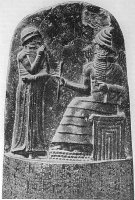
Worksheets and No Prep Teaching Resources
Reading Comprehension Worksheets
Ancient Mesopotamia

Ancient Mesopotamia
 Worksheets and No Prep Teaching Resources Reading Comprehension Worksheets Ancient Mesopotamia |
 Ancient Mesopotamia |
| edHelper's suggested reading level: | grades 9 to 11 | |
| Flesch-Kincaid grade level: | 9.58 |
|
The First Dynasty of Babylon
By Vickie Chao |

|
 1 Circa 2004 B.C. Mesopotamia was in a turbulent era! At the time, Ibbi-Sin, the last ruler of the 3rd dynasty of Ur, was having problems retaining control over his kingdom. On one hand, he worried about the Amorites, a nomadic Semitic tribe from the Middle East, whose growing influence was a good cause for concern. On the other hand, he had to put up with Ishbi-Erra, a general whose ambition reached no limit. As the two issues continued to plague him day and night, Ibbi-Sin saw power slowly slipping through his fingers. In spite of his best efforts, he never solved the problem. To make matters worse, sensing that the final days of the 3rd dynasty of Ur were fast approaching, Elam -- an ancient country in present-day southwestern Iran -- broke free and reasserted its independence. Shortly after reclaiming their sovereignty, the Elamites took Ur, the capital, under siege. When they finally sacked it, they arrested Ibbi-Sin and took him back to the city of Elam. That was the last we ever heard of him.
1 Circa 2004 B.C. Mesopotamia was in a turbulent era! At the time, Ibbi-Sin, the last ruler of the 3rd dynasty of Ur, was having problems retaining control over his kingdom. On one hand, he worried about the Amorites, a nomadic Semitic tribe from the Middle East, whose growing influence was a good cause for concern. On the other hand, he had to put up with Ishbi-Erra, a general whose ambition reached no limit. As the two issues continued to plague him day and night, Ibbi-Sin saw power slowly slipping through his fingers. In spite of his best efforts, he never solved the problem. To make matters worse, sensing that the final days of the 3rd dynasty of Ur were fast approaching, Elam -- an ancient country in present-day southwestern Iran -- broke free and reasserted its independence. Shortly after reclaiming their sovereignty, the Elamites took Ur, the capital, under siege. When they finally sacked it, they arrested Ibbi-Sin and took him back to the city of Elam. That was the last we ever heard of him. |
Create Weekly Reading Books
Prepare for an entire week at once! |
| Leave your feedback on The First Dynasty of Babylon (use this link if you found an error in the story) |
 |
Ancient Mesopotamia
|
 |
High School Reading Comprehensions and High School Reading Lessons
|
 |
Social Studies
|